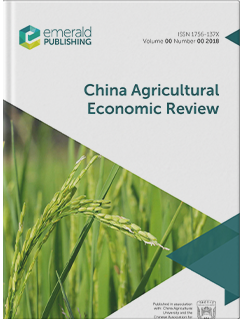The multiple effects of farmland infrastructure investment on agrifood systems in China—an interdisciplinary model analysis
IF 4.4
2区 经济学
Q1 AGRICULTURAL ECONOMICS & POLICY
引用次数: 0
Abstract
PurposeAs one of its major strategies, China has made a new plan to further expand High Standard Farmland (HSF) to all permanent basic farmland (80% of total farmland) for grain security over the next decade. Yet, what will be the impact of farmland infrastructure investment on agrifood systems? The paper aims to systematically evaluate the multiple effects (food security, economy, nutrition and environment) of expanding HSF construction under the context of the “Big Food vision” using an interdisciplinary model.Design/methodology/approachAn interdisciplinary model – AgriFood Systems Model, which links the China CGE model to diet and carbon emission modules, is applied to assess the multiple effects of HSF construction on agrifood systems, such as food security and economic development, residents’ diet quality and carbon emissions. Several policy scenarios are designed to capture these effects of the past HSF investment based on counterfactual analysis and compare the effects of HSF future investment at the national level under the conditions of different land use policies – restricting to grain crops or allowing diversification (like vegetables, and fruit).FindingsThe investments in HSF offer a promising solution for addressing the challenges of food and nutrition security, economic development and environmental sustainability. Without HSF construction, grain production and self-sufficiency would decline significantly, while the agricultural and agrifood systems’ GDP would decrease. The future investment in the HSF construction will further increase both grain production and GDP, improve dietary quality and reduce carbon emissions. Compared with the policy of limiting HSF to planting grains, diversified planting can provide a more profitable economic return, improve dietary quality and reduce carbon emissions.Originality/valueThis study contributes to better informing the impact of land infrastructure expanding investment on the agrifood systems from multiple dimensions based on an interdisciplinary model. We suggest that the government consider applying diversified planting in the future HSF investment to meet nutritional and health demands, increase household income and reduce carbon emissions.农田基础设施投资对中国农粮系统的多重影响--跨学科模型分析
目的 作为中国的一项重大战略,中国制定了一项新计划,在未来十年内将高标准农田(HSF)进一步扩大到所有永久基本农田(占总耕地面积的 80%),以保障粮食供应。然而,农田基础设施投资将对农业粮食系统产生何种影响?本文旨在利用一个跨学科模型,系统地评估在 "大粮食愿景 "背景下扩大农田水利建设的多重影响(粮食安全、经济、营养和环境)。设计/方法/途径应用一个跨学科模型--农粮系统模型,将中国专家咨询小组模型与膳食和碳排放模块联系起来,评估农田水利建设对农粮系统的多重影响,如粮食安全和经济发展、居民膳食质量和碳排放。在反事实分析的基础上,设计了几种政策情景来捕捉过去 HSF 投资的这些影响,并在不同的土地使用政策条件下(仅限于粮食作物或允许多样化(如蔬菜和水果)),比较 HSF 未来投资在国家层面的影响。如果不建设 HSF,粮食产量和自给率将大幅下降,农业和农粮系统的国内生产总值也将下降。未来对 HSF 建设的投资将进一步提高粮食产量和 GDP,改善膳食质量并减少碳排放。与将 HSF 限制为种植谷物的政策相比,多元化种植可提供更有利的经济回报、改善膳食质量并减少碳排放。我们建议政府考虑在未来的 HSF 投资中应用多样化种植,以满足营养和健康需求、增加家庭收入并减少碳排放。
本文章由计算机程序翻译,如有差异,请以英文原文为准。
求助全文
约1分钟内获得全文
求助全文
来源期刊

China Agricultural Economic Review
AGRICULTURAL ECONOMICS & POLICY-
CiteScore
9.80
自引率
5.90%
发文量
41
审稿时长
>12 weeks
期刊介绍:
Published in association with China Agricultural University and the Chinese Association for Agricultural Economics, China Agricultural Economic Review publishes academic writings by international scholars, and particularly encourages empirical work that can be replicated and extended by others; and research articles that employ econometric and statistical hypothesis testing, optimization and simulation models. The journal aims to publish research which can be applied to China’s agricultural and rural policy-making process, the development of the agricultural economics discipline and to developing countries hoping to learn from China’s agricultural and rural development.
 求助内容:
求助内容: 应助结果提醒方式:
应助结果提醒方式:


